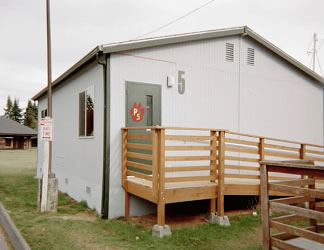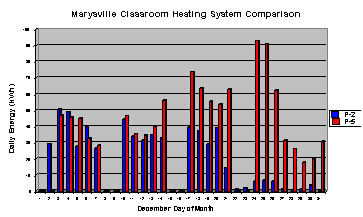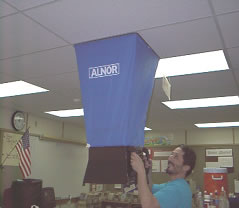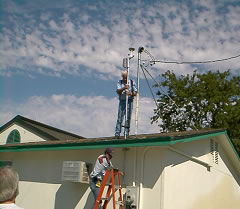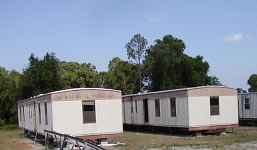|
BAIHP
Research: A. Manufactured Housing Research Cont'd
- Portable
Classrooms
Portland, OR; Boise,
ID; Marysville, WA
Project Overview
This is primarily a WSU (with subcontractors Oregon
and Idaho) and Pacific Northwest National Lab (PNNL)
task. Other partners include FSEC, UCFIE, the State Energy
Offices of Oregon and Idaho, school districts in Portland,
Oregon, in Boise, Idaho and Marysville, Washington, regional
utilities, manufacturers, and other stakeholders in the
Pacific Northwest.
The objective of this task is to promote the adoption
of energy efficient portable classrooms in the Pacific
Northwest that provide an enhanced learning environment,
high indoor air quality, and both substantial and cost-effective
energy savings. BAIHP staff focus on four main goals:
(1) offering technical assistance to portable classroom
manufacturers, school districts, and related organizations,
(2) field assessment, monitoring, and analysis of innovative
building technologies and energy saving features to determine
their value, (3) facilitation of collaborative agreements
among regional utilities, northwestern portable classroom
manufacturers and materials and equipment suppliers,
as well as school districts, and state education departments
and their affiliates, and (4) conducting and creating
educational opportunities to advance the widespread adoption
of energy efficient portable classrooms in school districts
nationwide.
The experiences working on the energy efficient portable
were instructive, particularly in the identification
of flaws in portable classroom design. The difficulties
that BAIHP staff encountered demonstrate the importance
of well-defined commissioning protocols, documentation,
and coordination among all personnel that service and
install HVAC equipment.
Findings:
- Portable classrooms in the Pacific Northwest are
occupied about 1225 hours per year, or about 14% of
the total hours in a year.
- The
average number of occupants in the standard 28’ x 32’ portable
classroom provide an internal heat of about 480 kWh/year,
or 8% to10% of space heating requirements.
- Most of the heat loss in portable classrooms manufactured
after 1990 occurs by air leaking through
the T-Bar dropped ceilings, because they have no sealed
air/vapor barrier. This newly created phenomenon occurred
with the incorporation of the less expensive dropped
T-Bar ceiling in place of the more expensive sheet
rock used in older portables. Air leakage also is increased
because of unsealed marriage lines - now used as
a low cost method of meeting the state attic ventilation
requirements.
- Since all portables tested in the project used a
simple seven-day programmable thermostat,
the HVAC systems operate during vacations and holidays.
- Energy codes in Washington, Oregon, and Idaho are
high enough to make beyond-code envelope
measures non cost-effective.
- Older portable classrooms under removal consideration
could be retrofitted with new energy efficiency
measures at much less cost than purchasing a new
portable classroom. Installing low-E, vinyl framed windows,
insulated doors, T-8 light fixtures, and caulking and sealing
air leaks can all be cost-effective when refurbishing older
portable classrooms. HVAC system replacement in older
portable classrooms will be the biggest single cost
item, ranging from $4500 to $6500.
- CO 2 sensors appear to be unreliable as a control
strategy. Those installed by field crews
and monitored by dataloggers in this study did not match
the readings shown by the CO 2 sensors which controlled
the ventilation systems.
Based on data analysis from years one through four,
the following measures were recommended. New portable
classroom procurement, setup, and commissioning as well
as existing classroom retrofit guidelines produced by
the BAIHP study can all be found in Appendix A.
Recommendations:
- Install 365 day programmable thermostats in all
existing portables and specify these thermostats
for new construction.
- In portable classrooms constructed with T-Bar dropped
ceilings, install an air/vapor barrier
above the T-Bar system on the warm side of the insulation.
Completely seal all edges and overlaps.
- If roof rafter insulation is used, seal the marriage
line at the roof rafter joint with approved
sealant such as silicon caulk or foam. Make sure
there is adequate ventilation between the insulation and
the roof.
- Conduct an audit of older portables scheduled for
disposal to determine if retrofitting would
be more cost effective than purchasing a new unit.
- Install occupancy sensors to control the ventilation
system.
- Specify that new portables contain windows on opposing
walls.
- Specify that new portable units contain exhaust
fans on the opposite side of the classroom
from the fresh air supply.
School
Partnerships
|
Figure 64 64 Energy
efficient portable classroom
at Pinewood Elementary
School in Marysville, Washington |
|
Figure 65 Graph
comparing heating system use of the Pinewood control
portable (P2-Blue) with the energy efficient portable
(P5-Red). Note the energy efficient portable’s
high energy use during the Christmas holidays due
to incorrectly configured heating system controls. |
Washington Schools - Pinewood Elementary
An 895 ft 2 portable classroom (P5) was sited at the
Pinewood Elementary School in Marysville Washington in
August 2000. This unit exceeded current Washington State
Energy Code standards with upgraded insulation in the
floor, roof and walls, low-E windows, and a sensor-driven
ventilation system that detects volatile organic compounds
(VOCs). A second portable, built in 1985, and also located
at Pinewood Elementary (P2), served as the control unit.
(Figure 64)
Energy
use comparisons of the two classrooms show that the energy
efficient portable used considerably more energy than
the control portable. This was attributable to several
factors:
- Incorrect wiring of the exhaust fan, causing it
to run continually. The fan was rewired
in 2000 during the summer break. Once corrected, energy
use in the portable declined.
- Incorrect programmable thermostat settings which
were not programmed to turn the heating
and cooling system off during holidays and vacations. Though
energy use was reduced when the portable was unoccupied,
use was still excessive (Figure 65).
- Higher air leakage in the energy efficient portable
than the control portable. Blower door
testing found 19 ACH at 50 Pa in the energy efficient classroom
compared to nine ACH at 50 Pa in the control classroom.
Follow-up blower door, smoke stick, and APT pressure
tests indicated that the predominant leakage path
tracked through the T-bar ceiling and into the vented attic
due to an ineffective air barrier in the energy efficient
portable. The control portable contains taped ceiling
drywall.
- No initial HVAC commissioning by the HVAC supplier
or the school district.
- Significant
HVAC system alterations (including rewiring,
ventilation system VOC sensor replacement with a
CO 2 sensor, and modifications to other aspects of the
HVAC control system) during 2001 by maintenance staff and
the HVAC supplier, unbeknownst to BAIHP staff. Calibration
testing done by scientists at the Florida Solar Energy
Center on the CO 2 sensors showed significant drift
in output results. This made data collected virtually unusable.
- The use of plug-in electric heaters during the winter
of 2001 by the resident teacher because
of room comfort problems. This led to significant room
temperature variations and monitoring data showed high
plug-load energy use.
- Poor
fresh air flow design with the fresh air intake and exhaust
fan positioned so they create a “short
circuit” of fresh air, bypassing the
students and teacher.
BAIHP staff proposed the following recommendations
to Pinewood Elementary:
|
Figure 66 Ventilation system
testing
at North Thurston School District. |
- Well-defined commissioning protocols, documentation,
and coordination among all personnel that
service and install the HVAC equipment. This is a critical
component of efficient and healthy classroom operation
and should include outside airflow rate measurements
to assess adequate ventilation and control testing
to insure correct system operation.
- Design changes to the portable classroom manufacturer,
including the use of a structural insulated
panel system (SIPS), tighter ceiling barrier and
sheetrock ceilings, elimination of the vented attic, and
relocation of the exhaust fan to the wall opposite the
supply air vent.
- Removal of current HVAC controls and replacement
with both an occupancy sensor-driven control
for the ventilation system and a heating system programmable
thermostat. Staff also proposed a classroom
on/off switch to simplify the system turnoff during
unoccupied summer and school vacations.
- Location of exhaust fans in future portables on
the wall opposite the supply air vent.
- Window installation on opposing sides of the classroom
to increase daylight penetration and to
assist in passive cross-ventilation.
Based on the above recommendations, WSU researchers
worked with Marysville school facility manager and customer
representatives from Snohomish Public Utility District
to assist them in setting new construction specifications
for 13 portable classrooms they will procure during the
next reporting period. Marysville School District will
specify a completely sealed ceiling barrier, a new model
heating/ventilation system, a 365 day programmable thermostat,
window placement on opposite sides of the classroom,
and exhaust fan placement on an opposite wall from the
fresh air supply.
Washington Schools - North Thurston School District
BAIHP staff also worked with the North Thurston School
District to troubleshoot a portable classroom in Lacey,
Washington. (Figure 66) The classroom was experiencing
high energy use and poor indoor air quality. BAIHP staff
tested the classroom, made recommendations including
opening the supply dampers, installing a wall side vent
to better ventilate the classroom and discussed the specification
development process with district staff. The North Thurston
School District now is including most of the measures
listed in the new procurement guidelines for their future
portable classroom purchases. The school district will
investigate the feasibility of installing an air/vapor
above the T-bar dropped ceiling and will record costs
for making these improvements.
Idaho Schools - Boise School District Retrofit
BAIHP
staff located a portable classroom at the West Boise
Junior High School in the Boise Idaho School District,
occupied by a teacher who was interested in having the
classroom monitored and retrofitted. The teacher also
is an Idaho State legislator active in education issues,
which staff members believe will increase the chances
of implementing the final recommendations. (Figure
67)
|
Figure
67 Weather
monitoring system installation in the Boise portable
classroom. |
BAIHP
staff performed a baseline audit, and installed monitoring
equipment to track the classroom’s
energy use during 2000. In 2001, the classroom was
retrofitted with an efficient HVAC system (controlled
by CO 2 sensors), lighting, and envelope measures.
The classroom was then reaudited, and monitored for
the remainder of the year.
BAIHP staff worked with Pacific Northwest National
Laboratories (PNNL) on the pre- and post-retrofit audits,
and installation of the monitoring equipment. In their
capacity of providing energy management services to the
school district, the local utility Avista Corporation,
collected lighting and occupancy data.
Monitoring data indicates a 58% reduction in energy
usage post-retrofit. Blower door tests indicate a reduction
in air leakage from nine ACH at 50 Pa to five ACH at
50 Pa. Data also revealed that heating use actually increased
on weekends and holidays because of lack of internal
heat gain and because the HVAC control systems are not
programmed to shut off on weekends and holidays. The
total retrofit cost was $9,892.
Monitored data suggests that the CO 2 sensor that controls
the HVAC system is not correctly configured. The system
does seem to react to an increase in CO 2 levels early
in the day, but does not remain on; CO 2 levels only
begin to significantly dissipate after one o'clock PM.
BAIHP researchers have noted the difficulty of correctly
configuring these sensors in other monitored classrooms.
Oregon Schools
Oregon BAIHP staff worked with the Portland Public
School District to procure two energy efficient classrooms.
These were constructed to BAIHP staff specifications
and included increased insulation, high efficiency windows,
transom windows for increased daylighting, a high efficiency
heat pump, and efficient lighting. Staff videotaped the
construction of one classroom.
Monitoring equipment was installed by PNNL staff. Estimates
using the software Energy-10 indicated a total energy
consumption of 9200 kWh, or $583 per year at Portland
energy rates. Measured results showed the Oregon portable
used about 6600 kWh for the monitored period.
Incremental costs for the energy efficiency measures
were $6,705 over Oregon commercial code, including approximately
$2,500 for the HVAC system. This suggests a simple payback
of 10 to12 years.
Initial blower door tests found air leakage rates of
11.3 ACH at 50 Pa. BAIHP staff also identified significant
leakage through the T-bar dropped ceiling and up through
the ridge vents. Other monitoring results indicated that
the same HVAC control problems exist with the Oregon
classroom as with the others studied in this project.
The
Energy Efficient model outperformed code level models in
the Portland area. The older the classroom, the more energy
consumed. Even when compared with new code level models
from the same year, the Energy Efficient model used 35%
less energy. Conventional code level classrooms do not
include energy efficient measures which greatly increases
the unit’s operating costs. Classrooms
built more than 10 years ago, use twice as much energy
as the efficient model. Those older than 20 years consume
more than three times the amount of energy. From this
study, researches determined that high performance
classrooms can save anywhere from $200 to $1000 dollars a
year in energy costs compared to older, less efficient portables.
A survey sent to teachers and maintenance staff indicates
a high degree of satisfaction with the efficient portables;
the teachers were most impressed with the improved indoor
air quality and increased light levels due to the daylighting
windows.
Historical Data Collection
In Idaho, Oregon, and Washington, BAIHP staff worked
with local utilities and school districts to obtain historic
energy use data on portable classrooms. This data will
be used to compare energy usage from the energy efficient
portables monitored in this study.
In Idaho, BAIHP staff worked with Avista Corporation's
energy manager to collect historic data on 14 portable
classrooms in the Boise School District. The classrooms
each were equipped with discrete energy meters; as
a result, BAIHP staff was able to obtain energy usage data
for the past three to four years. A procedure was developed
to collect information on portables at each school
in cooperation with the physical facilities manager and
each school lead. Historic data collection continues.
Site visits and walk-through audits are planned for
these 14 buildings.
WSU will continue to coordinate with PNNL and FSEC on instrumented
data collection on the portable classrooms being monitored
in Boise, Idaho, Marysville, Washington, and in Portland,
Oregon. WSU will work with Idaho to potentially procure
and test one prototype classroom with SIPS. Evaluate and
analyze the collected data and prepare articles for presentation
and publications.
- Duct
Testing Data from Manufactured Housing Factory Visits
Paper:
McIlvaine, Janet, David Beal,
Neil Moyer, Dave Chasar, Subrato Chandra. Achieving Airtight
Ducts in Manufactured Housing. Report No. FSEC-CR-1323-03.
Over
the past 10 years, researchers at FSEC have worked with
the Manufactured Housing industry under the auspices of
the U.S. Department of Energy (DOE) funded Energy Efficient
Industrialized Housing Program and the Building America
(BA) Program (www.buildingamerica.gov). FSEC serves as
the prime contractor for DOE’s fifth
Building America Team: the Building America Industrialized
Housing Partnership (BAIHP) which can be found online
at: www.baihp.org.
Data
and findings presented here were gathered between 1996
and 2003 during 39 factory visits at 24 factories of six
HUD Code home manufacturers interested in improving the
energy efficiency their homes. Factory observations typically
showed that building a tighter duct system was the most
cost effective way to improve the product’s
energy efficiency.
BAIHP and others recommend keeping duct system leakage
to the outside (CFM25 out) equal to or less than 3% of
the conditioned floor area, termed Qn out. However, most
homes seen in a factory setting cannot be sealed well
enough to perform a CFM25 out test. Results of many field
tests suggest that CFM25 out will be roughly 50% of total
leakage (CFM25 total). Thus, to achieve a Qnout of less
than 3%, manufacturers should strive for a CFM25 total
of less than 6% of the conditioned area (Qn total).
Researchers measured total duct leakage and/or duct
leakage to the outside in 101 houses representing 190
floors (single wide equals one floor, double wide equals
two floors, etc.). Ducts systems observed in these tests
were installed either in the attic (ceiling systems)
or in the belly (floor systems). Researchers tested 132
floors with mastic sealed duct systems and 58 floors
with taped duct systems.
Of the 190 floors tested by BAIHP, the results break
down thus:
For mastic sealed systems (n=132):
- Average
Qn total = 5.1% (n=124); 85 systems (68%) achieved the
Qn total ≤ 6% target.
- Average
Qn out = 2.4% (n=86); 73 systems (85%) reached the Qn
out ≤ 3% goal.
For taped systems (n=58)
- Average
Qn total = 8.2% (n=56); 19 systems (34%) reached the
Qn total ≤ 6% target.
- Average
Qn out = 5.7% (n=30), more than twice as leaky as the
mastic average; 5 systems (17%) reached the Qn out ≤ 3%
goal.
The
results show that, while it is possible to achieve the
BAIHP Qn goals by using tape to seal duct work, it is far
easier to meet the goal using mastic. What isn’t
illustrated by the results is the longevity of a mastic
sealed system. The adhesive in tape can’t stand
up to the surface temperature differences and changes
or the material movement at the joints and often fails.
Mastic provides a much more durable seal.
Typical factory visits consist of meeting with key personnel
at the factory, factory observations, and air tightness
testing of duct systems and house shells. A comprehensive
trip report is generated reporting observations and test
results, and pointing out opportunities for improvement.
This is shared with factory personnel, both corporate
and locally. Often, a factory is revisited to verify
results or assist in the implementation of the recommendations.
The most commonly encountered challenges observed in
the factories include:
- Leaky supply and return plenums
- Misalignment of components.
- Free-hand cutting of holes in duct board and sheet
metal.
- Insufficient connection area at joints.
- Mastic applied to dirty (sawdust) surfaces.
- Insufficient mastic coverage.
- Mastic applied to some joints and not others.
- Loose strapping on flex duct connections.
- Incomplete tabbing of fittings.
- Improperly applied tape
Duct system recommendations discussed in this report
include:
- Set duct tightness target Qn equal to or less than
6% total and 3% to outside.
- Achieve duct tightness by properly applying tapes
and sealing joints with mastic
- Accurately cut holes for duct connections
- Fully bend all tabs on collar and boot connections
- Trim and tighten zip ties with a strapping tool
- Provide return air pathways from bedrooms to main
living areas
Summary of BAIHP Approach to Achieving Tight Ducts in
Manufactured Housing:
- Set
goal with factory management of achieving Qnout<=3%
using Qntotal<=6% as a surrogate measurement
while houses are in production.
- Evaluate current practice by testing a random sample
of units
- Report Qntotal and Qnout findings; make recommendations
for reaching goals
- Assist with implementation and problem solving as
needed
- Evaluate results and make further recommendations
until goal is met
- Assist with development of quality control procedures
to ensure continued success
Finally, duct tightness goals can be achieved with minimal
added cost. Reported costs range from $4 to $8. These
costs include in-plant quality control procedures critical
to meeting duct tightness goals.
Achieving
duct tightness goals provides benefits to multiple stakeholders.
Improving duct tightness diminishes uncontrolled air (and
moisture) flow, including infiltration of outside air,
loss of conditioned air from supply ducts, and introduction
of outside air into the mechanical system. Uncontrolled
air flow is an invisible and damaging force that can affect
the durability of houses, efficiency and life of mechanical
equipment, and sometimes occupant health. With improved
duct tightness, manufacturers enjoy reduced service claims
and higher customer satisfaction, while homeowners pay
lower utility bills, breathe cleaner air, and have reduced
home maintenance.
- Crawl
Space Moisture Research for HUD Code Homes
Research led by David Beal
Manufactured Home Merchandiser, July 2005
|
Figure
68 The test units
in place. Note white ground cover under unit on left,
exposed dirt under unit on right. |
When
BAIHP started to respond to HUD code manufactures’ floor
damage complaints, the diagnosis often pointed to air
distribution system leaks which created negative pressure
in the house pulling hot, humid, outside air into air
conditioned spaces and unconditioned interstitial spaces
such as wall and floor cavities.
In some cases this led to condensation and rot. From
this research and the resultant recommendations, HUD
Code Home manufactures have learned to prevent such occurrences
and have dramatically improved distribution system air
tightness practically eliminating such problems For background
on this matter, see these sections of this report:
- Building Science and Moisture Problems in Manufactured
Housing
- BAIHP Field Visits to Moisture Problem Homes
- Manufacturers Participating in Building Science
Research
- Duct Testing Data from Manufactured Housing Factory
Visits
Successfully
sealing HUD code home crawlspaces may be the last piece
of the solution for preventing floor failures plaguing
homes in hot, humid climates. Merely curing the duct leakage
has proven not to enough to keep all floors intact. Proper
techniques to seal these crawlspaces need to be developed.
The research reported here and BAIHP’s research plan
for 2005 addresses this need.
Field Experience
BAIHP researchers have observed that some houses with
rotting floors have acceptably tight ductwork, suggesting
that factors other than distribution system dynamics
are influencing moisture flow. The rot manifests primarily
under vinyl flooring which acts a vapor barrier between
the conditioned space and floor substrate, which suggests
an external source of moisture. BAIHP researchers further
observed that the crawlspaces in these homes are damp
and musty, often showing signs of standing or running
water in the crawlspace.
FSEC concluded that the only uncontrolled moisture source
is the humid air in the crawl space of the home driven
by vapor pressure toward the cool conditioned space.
Several manufacturers address this potential moisture
source by requiring a vapor retarder to be placed over
the dirt in the crawl space prior to the installation
of the house. However, a further exacerbation of the
problem stems from the current trend toward extending
the siding of the house all the way down to the grade
level, in place of the traditional vented skirting. This
tends to reduce ventilation, the primary mechanism for
dissipating moisture leaching from the ground into the
crawls
Other researchers (www.crawlspaces.org)
have reported on sealed crawl spaces, and recommended
them as a solution to the crawl space moisture problem.
The findings from those studies indicate that merely
covering the ground without truly sealing the crawl space
is not sufficient to solve the problem of high crawl
space humidity. The joints and penetrations in the crawl
space must be seal to prevent air infiltration as well.
To
determine if sealed crawl space solution could be achieved
in HUD Code Homes, research needed to be done to address
the unique building techniques in that industry, namely
the use of vinyl skirting to enclose the crawl space. To
that end, in 2004, BAIHP conducted research utilizing two
single-wide manufactured houses at FSEC’s
auxiliary test site in Cocoa, FL..
The
crawl space research plan involved two unconditioned, singlewide
manufactured homes sited side-by-side, one home with a
ground cover under it, the other without a ground cover
(only exposed dirt.). A third identical home was available,
however, it was not called into use in this experiment.
In each of the two experiment houses, three different skirting
(crawl space enclosure) options were evaluated: open or
no skirting, perforated skirting, and solid skirting. The
solid skirting mimics the effect achieved by extending
siding down to the ground instead of stopping it at the
band joist, described above. Additional evaluations were
planned, however, the Florida’s
four hurricanes dramatically curtailed the testing
schedule.
The homes (all three) were instrumented with temperature
and humidity sensors, two in the crawl space and one
in the interior. The site has a weather station, recording
ambient conditions. The temperature and relative humidity
was used to calculate the dewpoint at the measurement
location.
Data Analysis, Interpretation, and Conclusions
The
presented data is the ambient dewpoint, the dewpoint of
the two crawl spaces. The ambient readings are subtracted
from the average of the two crawl space readings to show
the temperature difference or )T. The final column of the
table (“Difference”)
is the difference between the ground cover and the non-ground
cover crawl space, showing how much dryer a crawl space
with a ground cover is; negative numbers indicating that
the ground covered crawl space was dryer.
Table
40 Dewpoint Temperatures |
| . |
Ambient
Dewpoint
|
Dewpoint
with
Ground Cover
|
Delta
T
T
amb-T cwl
|
Dewpoint
with
No Ground Cover
|
Delta
T
T
amb-T cwl
|
Difference |
No Skirting
06/09 – 07/08
|
73.3 ºF |
73.3 ºF |
0.0 ºF |
73.3 v |
0.0 ºF |
0.0 ºF |
Perforated Skirting
07/18 – 07/30
|
73.5 ºF |
73.7 ºF |
0.2 ºF |
75.4 ºF |
1.9 ºF |
-1.7 ºF |
Solid Skirting
08/23 – 09/03
|
74.3 ºF |
76.3 ºF |
2.0 ºF |
78.6 ºF |
4.3 ºF |
-2.3 ºF |
This data clearly illustrate a potential problem for manufactured
houses, or any home on a crawl space. As can be seen, the
average crawlspace dewpoint with skirting and no ground cover
was over 75 0F. Both crawlspaces with solid skirting were
above 76 0F. Any surface in the crawl space that is at or
below the dewpoint will condense moisture. Surfaces that
could be problematic are exposed floors, A/C ductwork, and
plumbing. Also, note that these numbers are averages gathered
over at least one week of measurements. The maximums are
much higher in all cases, but of a short duration.
The research shows that if a ground cover and perforated
skirting are used, the dewpoint in the crawl space will stay
near the ambient dewpoint, on average. Often, this is sufficient
to avoid problems in homes with crawl spaces. However, if
overly cool conditions are maintained in the house (interior
temperatures below the ambient dewpoint), problems can still
occur.
Research (www.crawlspaces.org)
into site built housing with block stem walls has shown that
unvented crawlspaces with a ground cover are significantly
dryer than vented crawlspaces if they start out as a dry
crawlspace or provisions were made to dry them out after
completion, such as a dehumidifier or supply air provided
to the space. However, the BAIHP data from the “solid
skirting and a ground cover” condition do not support
this conclusion.
The conclusion is that the solid skirting did not create
an adequate seal of the crawl space, allowing significant
moisture into the crawlspace. Suspected entry paths for the
moisture intrusion were along the joint behind the skirting
starter strip, as well as under the molding used to hold
the skirting in place at the ground.
HUD
code homes (and older site built homes) placed on piers
and skirted pose unique challenges to executing the sealed
crawl spaces detail. To overcome the air infiltration points
associated with skirting described above (at the top and
bottom of the skirting) a continuous vapor barrier is needed
from the band joist down to and covering the ground. This
however would interfere with visual inspect for termite mud
tunnels, possibly voiding the termite protection company’s
bond. The problem is overcome in crawlspaces with a block
walls by stopping the vapor barrier a few inches below the
band joist, to allow for inspection.
Planned Research for Summer of 2005
To
further research into finding a successful way to seal
the crawlspaces of HUD code housing, BAIHP installed a
vapor retarder in our on-site, well instrumented, manufactured
housing laboratory (MHLab) in March of 2005. The experiment
will investigate ways to allow for insect inspection, as
well as sealing around penetrations such as piers, anchors,
plumbing, and A/C duct work (to package units). The research
will also address ways to dry the crawlspace, both from
ambient moisture and potential flood problems. This may
include a dedicated sump pump and dehumidifier, or the
house’s
own A/C system.
Air
tightness testing of the “sealed” crawl
space showed that although the crawl space is much tighter
than that provided by solid skirting, it is still too leaky.
Further attempts will be made to seal the crawl space by
June 2005. When the space is sealed satisfactorily, conditioned
air from the house will be introduced into the crawl space
and its affect on the humidity level will be monitored.
This
BAIHP research has been accepted by the trade journal “Manufactured
Home Merchandiser” in an effort to get the information
to the people in the manufactured home industry that can
alter installation requirements. The anticipated publication
date is the July 2005 issue.
|


 You
are here: >
You
are here: > 